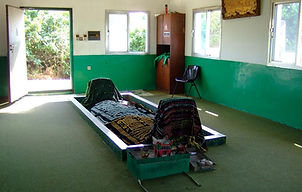Salalah, located in southern Oman's Dhofar Region, is renowned for its stunning landscapes and unique Khareef (Monsoon) season. This annual event, from July to September, transforms the desert terrain into lush greenery, with hills enveloped in white fog and gentle rains cooling the air. As the capital of Dhofar province, Salalah boasts banana plantations, Arabian Sea beaches, and vibrant marine life.
.jpg)
Tomb of Prophet Job (Nabi Ayoub)
This revered tomb is believed to be the final resting place of the biblical figure Prophet Job. With its tranquil surroundings and spiritual atmosphere, the Tomb of Prophet Job offers a serene sanctuary for reflection and prayer.

Museum of the Frankincense Land
This captivating museum offers a fascinating glimpse into the rich history and significance of frankincense in the region. Explore interactive exhibits, archaeological artifacts, and immersive displays that trace the ancient trade routes and cultural importance of this precious commodity.

Al Balid Archeological Site
This UNESCO World Heritage Site offers a fascinating glimpse into the ancient civilizations that once thrived in the region. With its well-preserved ruins and informative exhibits, you can explore the remnants of old settlements, ancient mosques, and fortified walls that date back centuries.

Haffa Souk
The market, also known as Al Hosn or Al Husn Souk, sits beside Al Hosn Palace, a beach and coconut groves. Al Haffa souk is Salalah’s oldest and most fragrant and is known for the Dhofari frankincense besides souvenirs and textile shops.

Tawi Ateer
Tawi Ateer translates to 'Bird's Well,' and it was so-called because of the birds that used to come and drink water from its depths. A sinkhole is a natural occurrence that is formed due to a collapse of underground limestone and is known to be one of the largest solvent sinkholes in the world.

Ain Razat
It is a picturesque collection of natural springs in Salalah, some of which flow year-round while others appear only during the Khareef (monsoon season). This beautiful spot, surrounded by lush greenery, is a popular destination all year round and serves as one of Salalah's primary water sources.

Ain Garziz
Nestled in the hills around Salalah, it is a popular destination known for its serene atmosphere and picturesque scenery. The spring often flows generously, creating a beautiful pool at the base of steep cliffs adorned with large fig trees and unique limestone formations, which can be enjoyed all year round.

Wadi Darbat
This picturesque valley is a haven of tranquility, boasting lush greenery, flowing streams, and cascading waterfalls. During the Khareef (monsoon) season (July to September), the valley transforms into a verdant oasis, attracting visitors with its stunning beauty.

Sultan Qaboos Mosque Salalah
It is the largest mosque in Salalah and Dhofar; blending traditional Islamic design with modern elements, the mosque features a main prayer hall for 2,500 worshippers, a beautiful courtyard, a library, and an auditorium. The impressive 50m dome, made of 14,000 tons of marble, and four 90-meter minarets, highlights its architectural grandeur

Taqah Castle
Taqah Castle, a well-preserved 19th-century fort, offers a fascinating glimpse into the history of this sardine-producing town. Located in the picturesque fishing village of Taqah, the castle features a furnished interior, informative signage, and a booklet detailing the town's rich history.

Al Mughsail Beach
Al Mughsail Beach is a stunning stretch of blue water and white sand, flanked by picturesque mountains. During the Khareef season, its blow hole jets can reach up to 28 meters, making Al Mughsail Beach a must-visit attraction.

Jebel Samhan
This towering mountain range offers breathtaking vistas and exhilarating hiking trails for outdoor enthusiasts. With its rugged terrain and diverse wildlife, Jebel Samhan provides an unforgettable adventure amidst nature's splendor.

Nabi Imran Tomb
This tomb holds the record for the longest grave in the world, measuring an intriguing forty-one feet. This site is the resting place of the revered Islamic prophet, Prophet Imran (PBUH). Nestled in the hills of Dhofar, the tomb is a simple rectangular building with small windows, lacking the domes typical of other tombs in Salalah.

Sumhuram
An ancient port city perched on a small hill by Khor Rori Creek, dating from the 4th century BC to the 4th century AD, this UNESCO World Heritage Site is one of Oman's oldest settlements. Sumhuram was once a thriving hub for the frankincense and copper trade.

Ubar
One of the ancient sites in the Dhofar region where archaeologists using remote sensing equipment discovered the city's remains in 1992. Ubar is thought to have been inhabited from approximately 2800 BC to approximately 300 AD and was an important trading center for frankincense before being buried in the rising dunes.

Mirbat
Mirbat is a fascinating town with a rich history and culture. It is home to a number of fascinating historical sites, including the Old Town, the ancient city walls, and the historic port. The town also
boasts beautiful mosques, such as the Al-Maarif Mosque and the Al-Jame’a Mosque.



